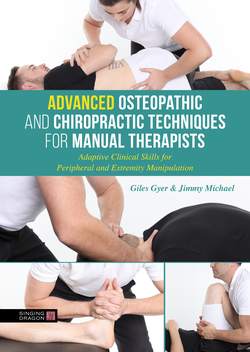Читать книгу Advanced Osteopathic and Chiropractic Techniques for Manual Therapists - Giles Gyer - Страница 16
На сайте Литреса книга снята с продажи.
Segmental inhibition
ОглавлениеThe concept of this mechanism is based on Melzack and Wall’s (1965) gate control theory of pain. This theory proposes that nociceptive (small diameter) A-delta (A-δ) and C sensory fibres carry the pain stimuli to the dorsal horn and ‘open’ the substantia gelatinosa layer, whereas non-nociceptive (large diameter) A-β fibres inhibit the transmission of pain signals by blocking the entry of A-δ and C fibres. Because mechanical stimulus applied during spinal manipulation may alter peripheral sensory input from paraspinal tissues, it has been presumed that manipulation may influence the gate-closing mechanism by stimulating the A-β fibres from muscle spindles and facet joint mechanoreceptors (Potter et al. 2005). Systematic reviews by Millan et al. (2012) and Coronado et al. (2012) have critically reviewed studies that examined the hypoalgesic effects of spinal manipulation on experimentally induced pain. Most of the studies included in these two reviews observed a segmental hypoalgesic effect of manipulation, and suggested that supraspinal pathways might be involved in the segmental mechanism. In addition, the involvement of a segmental mechanism in the modulation of pain perception has also been proposed by numerous studies investigating the neuromuscular effects of spinal manipulation (see ‘Neuromuscular effects’). However, it needs to be determined whether the observed local hypoalgesic effect following manipulation is merely a reflex effect on the pre-existing painful condition itself or due to activation of the endogenous pain inhibitory system.
